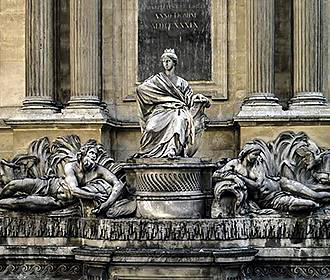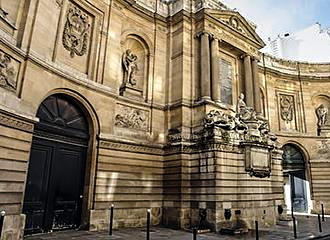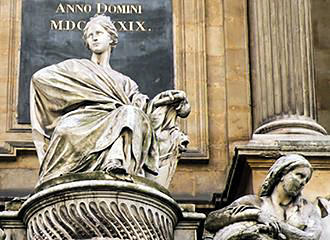Fontaine des Quatre-Saisons fountain of the four seasons
The Fontaine des Quatre-Saisons translates to the Fountain of the Four Seasons and was one of the monumental fountains built in Paris in the 18th century to provide drinking water to its residents and this was the largest and most ornate fountain to be built during this time.
A bit of history on Fontaine des Quatre-Saisons
It was during the reign of King Louis XV in the early part of the 1700s the council were discussing the idea of creating a new fountain within the Faubourg Saint-Germain area Paris to provide drinking water for the growing number of residents now locating to this part of the city.
Initially, they were looking at Rue de l’Universite and then Rue Saint-Dominique, but they finally decided upon the Rue de Grenelle, which was on a bit of land that was owned by the convent of Recollettes.
But the plans were not approved until later on in 1739, and the task of building this monument in Paris was given to the royal sculptor Edme Bouchardon, who worked on this impressive fountain for almost seven years before it was finally completed and opened to the public in 1745.
Also, the Fontaine des Quatre-Saisons was to become the largest and most impressive of all fountains constructed during this time, yet there was a considerable amount of criticism because of the lack of water spouts and water in general coming from it. In addition to this, many thought that it should have been constructed in a public square in full view, rather than down a narrow road.
About the Fontaine des Quatre-Saisons
Now, this extremely ornate and large fountain in Paris is one of the best surviving examples of public architecture dating from the reign of King Louis XV and at the time it had a double purpose, as not only was it to supply drinking water to residents of the city, but it was to showcase King Louis XV to the people as well.
And when you first look at the facade of the Fontaine des Quatre-Saisons you will be able to see an inscription in Latin that was produced in gold letters engraved onto black marble, and this inscription was written personally by Cardinal de Fleury, who was the Kings chief minister.
Also, when you look at figures that are visible on the fountain, these were all produced by the sculptor Edme Bouchardon and the main figure in the centre, is a woman on a throne and this is meant to represent the city of Paris.
Then on either side of this centre figure are two others and to the right it is designed to represent the River Seine and the left represents the River Marne and these three are in marble along with the bas-relief behind.
But, the remaining sculptures were designed in stone and this monument in Paris actually has two wings with four inset bas-relief sculptures that are designed to represent the spirit of the four seasons, and hence why it was called the Fountain of the Four Seasons.
So each of these are a person with wings carrying fruit that would be available in each season, and the idea was to show the abundance Paris had no matter what the time of year and below these niches there are additional bas-reliefs that depict children playing.
Now as we mentioned earlier, there are actually only two faucets, or mascarons, commonly known as spouts for filling vessels of water, and these are made out of bronze in the shape of lions heads.
An interesting fact that you may not know, is that the water was stored in the upper part of the fountain and fed down by gravity to be collected by the residents or by water porters who would collect it and take to other parts of the city and sell it.
Access to the Fontaine des Quatre-Saisons
Located in the 7th Arrondissement of Paris, the Fountain of the Four Seasons is situated right next to the Musee Maillol, which is an art museum in Paris that was established by the model of the sculptor Aristide Maillol.
Situated on the Rue de Grenelle, please do bear in mind that the Rue de Grenelle is a very long road and at the end of the road if you are travelling in a westerly direction you would reach Les Invalides with the Musee de l’Armee and much more.
So to give you a better idea of the fountain position, it is situated in between the Rue du Bac and the Boulevard Raspail, with the nearest Metro station being in a northerly direction called the Rue du Bac stop serving Line 12, although going in a southerly direction a little further walk and you have the Sevres - Babylone stop serving the Metro Lines 10 and 12.
However, other means of public transport that will get you close to the Fontaine des Quatre-Saisons include the Bus Lines 63, 68, 69, 83, 84, 87 and 94 along with the Noctilien Night Bus Service via Line N02.
Address details
Fontaine des Quatre-Saisons, 57-59 Rue de Grenelle, 75007, Paris, Ile de France, France
Related information
Drinking Water Fountains
Transport options
Paris Metro lines 10, 12
Bus lines 63, 68, 69
Bus lines 83, 84, 87
Bus line 94
Night bus line N02
Attractions close by
Musee Maillol
Square des Missions Etrangeres
Hotel Matignon
Square Taras-Chevtchenko
Square Boucicaut
Chapelle Notre Dame de la Medaille Miraculeuse
Jardin Catherine Laboure
Musee d’Orsay
Musee National de la Legion d’Honneur
Musee Rodin
Hotel National des Invalides
Eglise Saint Joseph des Carmes
Musee Eugene Delacroix


